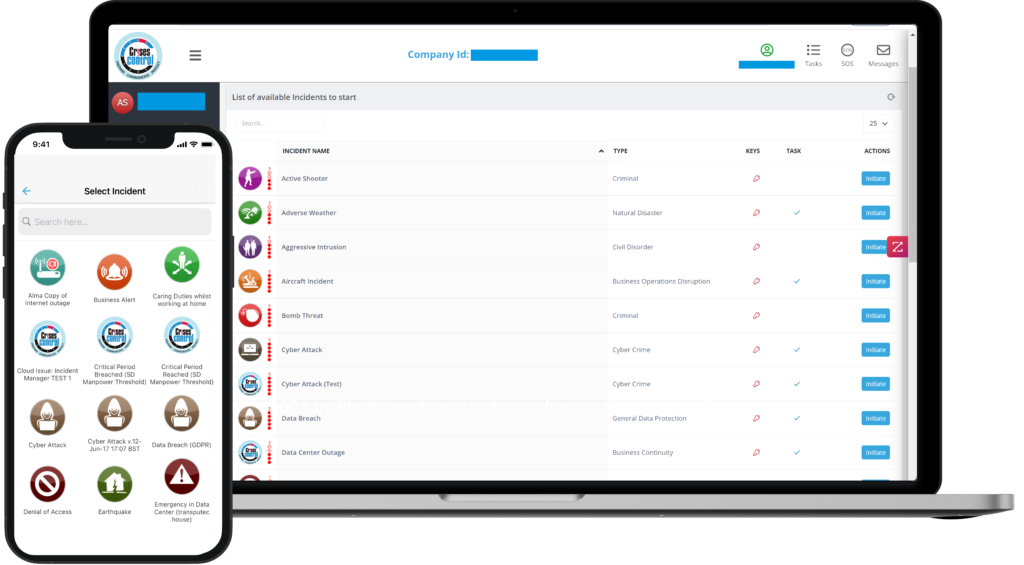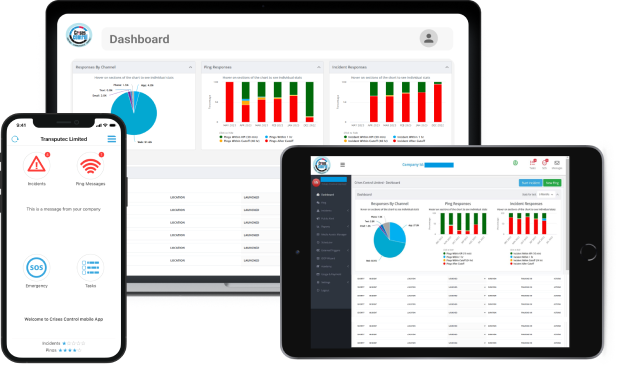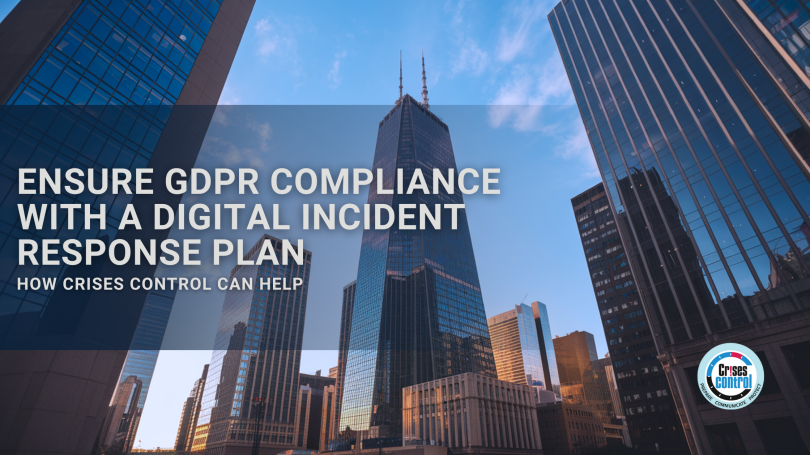Written by Anneri Fourie | Crises Control Executive
In 2023, the average cost of a data breach reached an all-time high of $4.45 million. The General Data Protection Regulation (GDPR) mandates that businesses report data breaches to the relevant supervisory authority within 72 hours. Failing to comply can result in substantial fines and reputational damage. For instance, Booking.com was fined €475,000 for reporting a data breach 22 days late.
Given these stakes, having a structured incident management system is not just advisable, but essential. This blog explores the challenges of GDPR compliance in incident management and how a digital response plan, particularly through Crises Control’s GDPR compliance platform, can help businesses navigate these challenges effectively.
The Challenge of GDPR Compliance in Incident Management
GDPR sets stringent requirements for data breach management, and many organisations struggle to meet these due to outdated or inadequate processes.
The 72-Hour Breach Notification Rule
As mentioned, GDPR requires that any personal data breach be reported to the appropriate supervisory authority within 72 hours of discovery. This tight timeframe leaves little room for error. Without automated systems, gathering necessary information and coordinating a response can be chaotic, increasing the risk of missing the deadline.
Failure to Detect and Respond to Breaches
Many data breaches remain undetected for extended periods. Without real-time monitoring, suspicious activities can go unnoticed, allowing breaches to escalate. This delay not only violates GDPR’s prompt reporting requirement, but also amplifies potential harm to individuals and the organisation.
Inefficient Communication During a Crisis
Effective communication is crucial during a data breach. However, many organisations rely on disjointed communication channels, leading to confusion and delays. A lack of clear protocols can result in inconsistent messaging, further complicating the incident response and recovery process.
Lack of an Audit Trail
GDPR mandates that organisations demonstrate how they handle personal data breaches, including the actions taken and timelines. Without a centralised system to log these actions, compiling an accurate audit trail can be time-consuming and prone to errors, hindering compliance efforts.
The Role of a Digital Incident Response Plan in GDPR Compliance
A digital incident response plan provides a structured approach to managing data breaches, ensuring that all necessary steps are taken promptly and efficiently.
Automating Breach Reporting
Automation ensures that once a breach is detected, the necessary notifications are generated and sent to the appropriate authorities within the required timeframe. This reduces the reliance on manual processes, minimising the risk of human error and ensuring compliance with the 72-hour reporting rule.
Enhancing Detection and Response Times
Digital incident management systems offer real-time monitoring and alerts, enabling organisations to detect breaches as they occur. This immediate awareness allows for swift action to contain and mitigate the breach, reducing potential damage and demonstrating a proactive approach to data protection.
Streamlining Communication
A centralised platform facilitates seamless communication among all stakeholders during a crisis. Predefined roles and responsibilities ensure that everyone knows their tasks, reducing confusion and enabling a coordinated response. This clarity is vital for maintaining trust with customers and regulators.
Maintaining a Centralised Audit Trail
Digital platforms automatically document all actions taken during an incident, creating a comprehensive and tamper-proof audit trail. This record is invaluable during regulatory investigations, as it provides clear evidence of compliance efforts and the steps taken to address the breach.
How Crises Control’s GDPR Compliance Platform Helps Businesses Stay Compliant
Crises Control provides businesses with a powerful compliance management solution, enabling them to manage security incidents efficiently and meet GDPR requirements with confidence. The platform streamlines incident response, automates compliance reporting, and ensures secure communication, helping organisations minimise risk and demonstrate regulatory adherence.
Real-Time Incident Detection and Alerts
Crises Control’s Incident Manager enables organisations to identify and respond to security incidents quickly. The platform provides real-time alerts, ensuring that key stakeholders are notified as soon as a potential data breach occurs. By reducing the time between detection and response, businesses can mitigate the impact of breaches and maintain GDPR compliance.
Structured Incident Response Workflows
Crises Control’s Incident Plan Builder allows businesses to create predefined response workflows tailored to GDPR-related security incidents. These workflows guide teams through every step of the response process, ensuring all necessary actions are taken systematically. By reducing confusion and response times, businesses can prevent compliance failures and minimise regulatory risks.
Secure Communication and Collaboration
Effective communication is critical during a data breach, and GDPR mandates that sensitive information is handled securely. Crises Control provides encrypted, role-based communication through Ping Mass Notifications and Task Manager, ensuring that only authorised personnel have access to confidential data. This secure collaboration helps teams coordinate their response while maintaining compliance with data protection regulations.
Centralised Audit Trail and Compliance Documentation
GDPR requires businesses to maintain detailed records of how they handle security incidents. Crises Control’s Incident Reporting and Audit feature automatically logs all actions taken during an incident, creating a comprehensive audit trail. This documentation simplifies regulatory reporting, helps businesses demonstrate compliance, and provides valuable insights for improving future incident response strategies.

Interested in our Incident Management Software?
Customise your Crisis Incident Management Software to meet your specific needs with our flexible tools & stay connected and informed during the crisis and incident management process
The Business Benefits of a Digital Incident Response Plan
Beyond ensuring GDPR compliance, a digital incident response plan provides businesses with a structured and efficient approach to managing data breaches and other security incidents. This not only reduces regulatory risks, but also strengthens a company’s overall resilience, protects its reputation, and enhances operational efficiency. Here’s how:
Minimising Financial Losses
A data breach can have severe financial consequences, ranging from regulatory fines and legal fees to lost revenue due to downtime and reputational damage. A digital incident response plan helps businesses mitigate these risks in several ways:
- Faster Response Times: Immediate detection and response reduce the duration and impact of a breach, preventing further financial loss.
- Avoiding GDPR Fines: Automated compliance reporting ensures breaches are reported within 72 hours, preventing hefty penalties.
- Minimising Business Disruption: Structured workflows keep operations running smoothly even during a crisis, reducing revenue loss from downtime.
- Lowering Incident Management Costs: Automating incident response reduces the need for extensive manual intervention, saving time and resources.
By proactively managing security incidents, businesses can significantly cut costs related to breach recovery and long-term reputational damage.
Enhancing Customer Trust
As we know by now, customers expect businesses to safeguard their personal data. A company’s response to a data breach can either strengthen or weaken customer confidence. Mishandling an incident, whether through delayed notification, lack of transparency, or failure to secure affected data, can lead to customer churn, negative press, and long-term damage to brand reputation. A well-structured digital incident response plan helps build trust and credibility by ensuring:
- Transparent and timely communication: Customers are informed promptly about security incidents, demonstrating accountability.
- Secure handling of sensitive information: Encrypted and role-based communication ensures that only authorised personnel access customer data.
- Swift containment of breaches: A quick and organised response reassures customers that their data is being protected.
A robust incident response plan ensures that businesses retain customer trust, even in crisis situations.
Improving Internal Efficiency
Without a digital incident response plan, security teams often scramble to coordinate a response, manually track incidents, and compile compliance reports, leading to confusion, inefficiencies, and increased risk of non-compliance. An automated system removes these inefficiencies by providing:
- Predefined Response Workflows: Ensuring teams follow structured protocols, reducing response times and minimising errors.
- Automated Notifications: Instantly alerting the right personnel when a breach occurs, eliminating delays in incident response.
- Centralised Communication: A single platform for secure collaboration prevents information silos and ensures a coordinated response.
- Audit-Ready Documentation: Incident reports are automatically logged and stored, reducing administrative workload and ensuring compliance with GDPR’s documentation requirements.
By removing manual processes and optimising workflows, businesses can handle incidents with greater speed and efficiency, allowing teams to focus on preventing future threats rather than firefighting existing ones.
Strengthening Cybersecurity Defences
A digital incident response plan is not just about responding to threats, it’s about proactively strengthening cybersecurity. By continuously monitoring for threats, identifying vulnerabilities, and improving security measures, businesses can prevent breaches before they happen.
- Continuous Improvement: Post-incident analysis helps businesses refine their security policies and response procedures.
- Regular Testing & Simulations: Tabletop exercises ensure that teams remain prepared and confident in handling real incidents.
- Integration with Security Tools: Seamless integration with SIEM (Security Information and Event Management) systems enhances an organisation’s cyber resilience.
By adopting a proactive, rather than reactive approach, businesses not only comply with GDPR regulations, but fortify their overall cybersecurity posture, reducing the likelihood of future attacks.
Final Thoughts
With GDPR enforcement becoming increasingly strict and data breaches on the rise, businesses cannot afford to take a reactive approach to incident management. Implementing a digital incident response plan ensures compliance, minimises financial and reputational damage, and improves overall security posture.
Crises Control’s GDPR compliance platform provides businesses with the tools needed to manage incidents effectively, from real-time breach detection to automated reporting and secure communication. By investing in a structured and technology-driven approach, organisations can navigate the complexities of GDPR with confidence and focus on what matters most—protecting their customers and their business.
Don’t wait until a data breach occurs to put a plan in place. Book a free personalised demo of Crises Control today and discover how our platform can help your organisation stay compliant, respond effectively to incidents, and safeguard sensitive data.
Request a FREE Demo









